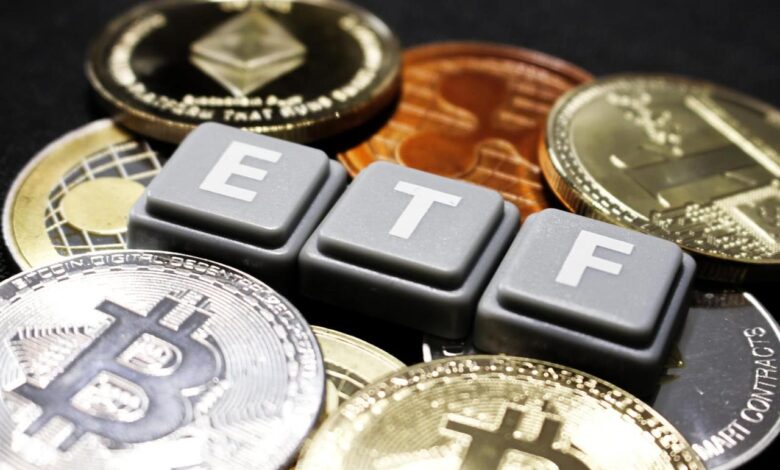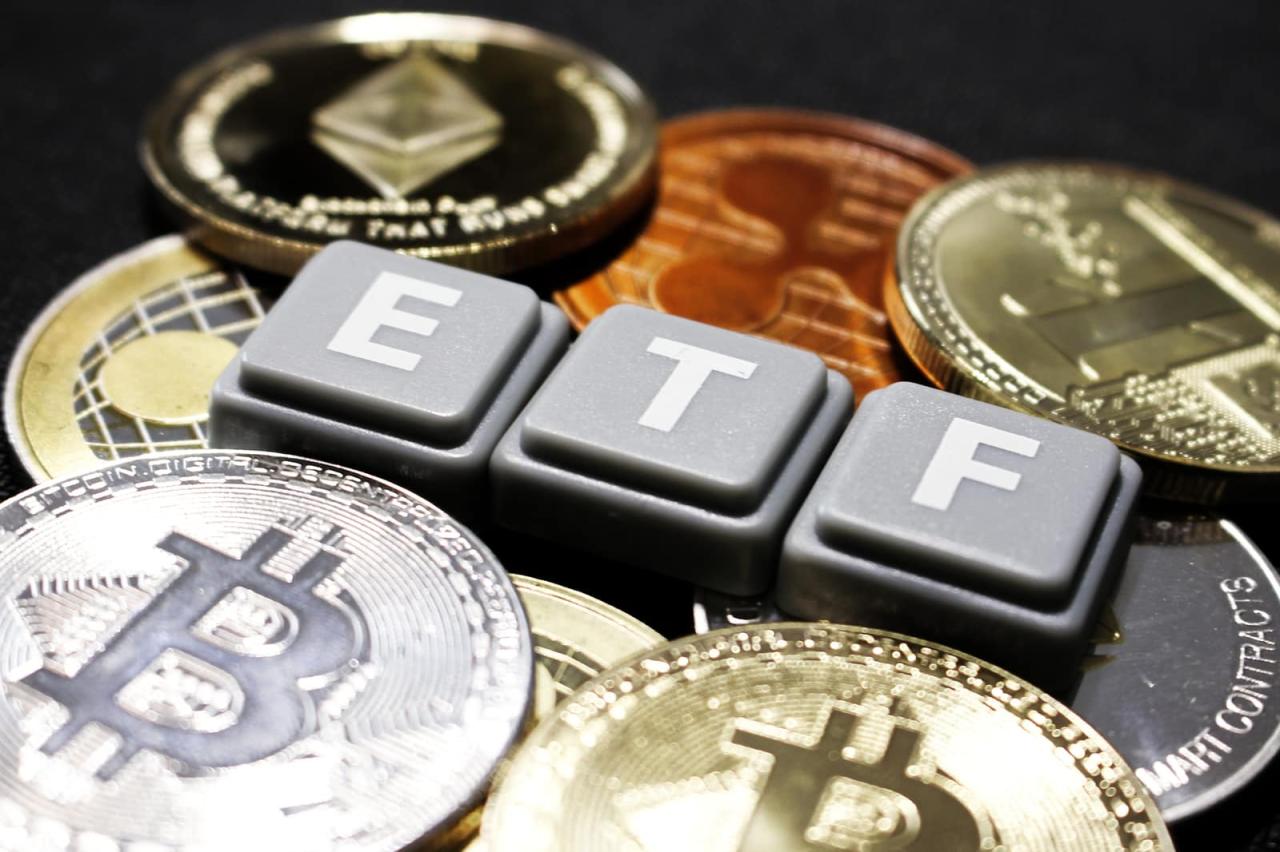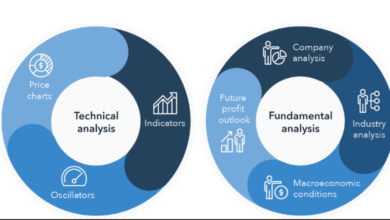
Bitcoin ETFs Cryptos Future is Now
Why Bitcoin ETFs Will Change the Future of Crypto Investments. This exciting prospect opens up a new world of possibilities for crypto investors, potentially revolutionizing how we approach this burgeoning asset class. Imagine the ease of access, the increased liquidity, and the potential for greater stability. This detailed look dives deep into the mechanics, market impact, and regulatory landscape of Bitcoin ETFs, exploring the potential benefits and challenges they present.
Bitcoin ETFs represent a significant step forward in the mainstream adoption of cryptocurrencies. Their potential to broaden access, increase liquidity, and potentially reduce volatility makes them a compelling investment opportunity. We’ll explore the intricacies of how these funds function, examining their impact on various investor types and the regulatory framework that shapes their development.
Introduction to Bitcoin ETFs
Bitcoin Exchange Traded Funds (ETFs) are a relatively new but rapidly growing asset class in the cryptocurrency market. They represent a significant advancement in how institutional investors and retail traders can access exposure to Bitcoin’s price performance without directly owning the cryptocurrency itself. This streamlined approach provides a more accessible and regulated way to participate in the Bitcoin market.Bitcoin ETFs function as a security traded on established stock exchanges.
Similar to traditional ETFs, they track the price of Bitcoin, allowing investors to buy and sell shares throughout the day, much like any other publicly traded stock. The key mechanism is that the ETF holds assets that correlate directly with Bitcoin’s price, often in the form of Bitcoin futures contracts or other derivative instruments. This allows for daily valuation and liquidity, unlike direct Bitcoin ownership, which can be subject to volatility and transaction costs.
Bitcoin ETF Mechanics
Bitcoin ETFs operate through a combination of mechanisms that mimic the performance of Bitcoin while providing a regulated and accessible investment vehicle. The core function is to replicate the price movements of Bitcoin, although the exact methods for doing so vary. Some ETFs use Bitcoin futures contracts, while others may use Bitcoin-linked derivative instruments. This structure is designed to offer investors the benefits of exposure to Bitcoin’s price fluctuations without requiring them to directly own or manage the cryptocurrency.
Different Types of Bitcoin ETFs
Several Bitcoin ETFs are currently available or in development, each with its own unique features and characteristics. These differences often revolve around the specific assets held within the ETF to replicate Bitcoin’s performance. Some ETFs may be more closely tied to Bitcoin’s price movements, while others might have slightly different correlations, depending on the methods used. There is currently no standardized approach, with each ETF having its own set of nuances.
Comparison with Other Crypto Investment Options
Bitcoin ETFs provide a different investment experience compared to other crypto options. Direct cryptocurrency purchases, for example, often involve more complexities, such as the need for cryptocurrency wallets, security considerations, and fluctuating exchange rates. Conversely, trading Bitcoin futures contracts or other derivatives requires specific knowledge and expertise, and often carries higher levels of risk. ETFs simplify the process by allowing investors to gain exposure to Bitcoin’s performance within a familiar financial framework.
A direct purchase of Bitcoin involves managing the currency, handling transactions, and ensuring safety. Trading futures or derivatives, requires expertise in derivatives markets.
Key Features and Differences of Bitcoin ETFs
| ETF | Underlying Assets | Trading Venue | Expense Ratio | Key Characteristics |
|---|---|---|---|---|
| Example ETF 1 | Bitcoin futures | NYSE Arca | 0.50% | Lower entry point, futures based |
| Example ETF 2 | Bitcoin-linked derivatives | NASDAQ | 0.75% | Higher potential returns, derivative based |
| Example ETF 3 | Basket of crypto assets | CBOE | 0.60% | Diversified portfolio, broader crypto exposure |
This table highlights the diverse nature of Bitcoin ETFs, with variations in their underlying assets, trading venues, and expense ratios. The differences in these factors can significantly impact an investor’s experience and the potential return.
Impact on Investor Access

Source: crypto-news.net
Bitcoin ETFs promise to revolutionize crypto investment, opening doors for a wider range of investors to participate in the digital asset market. Traditionally, Bitcoin investment has been a complex and often inaccessible process, requiring specialized knowledge and potentially high transaction costs. ETFs are designed to make this process much smoother, bringing Bitcoin to a broader audience.Bitcoin ETFs will likely broaden access to Bitcoin for retail investors by streamlining the investment process.
Bitcoin ETFs are poised to revolutionize crypto investing, making it more accessible and mainstream. However, the future of these investments also hinges on factors like the integration of the Internet of Things (IoT) into cryptocurrency transaction systems, as explored in Understanding the Impact of IoT on Cryptocurrency Transaction Systems. Ultimately, these technological advancements will play a crucial role in shaping the future of Bitcoin ETFs and their broader impact on the crypto market.
The structured nature of ETFs allows for easier purchase and sale through existing brokerage platforms, eliminating the need for complex and potentially risky direct purchases on cryptocurrency exchanges. This simplified approach will attract a new cohort of investors, including those with limited knowledge of the crypto space.
Bitcoin ETFs are poised to revolutionize crypto investing, making it more accessible and mainstream. This opens up exciting possibilities for diversifying your portfolio and creating a balanced investment strategy between traditional markets and crypto, a topic I explore in more detail here: Creating a Balanced Investment Strategy Between Traditional Markets and Crypto. Ultimately, the increased liquidity and institutional backing offered by ETFs will significantly influence the future of crypto investments.
Potential for Increased Participation and Liquidity
The introduction of Bitcoin ETFs is expected to significantly increase participation in the crypto market. By making Bitcoin investments more accessible, ETFs can attract a wider range of investors, from individual retail investors to institutional investors who previously lacked the necessary tools or confidence to enter the market. This increased participation directly correlates with higher liquidity, which stabilizes market prices and makes it easier to buy and sell Bitcoin.
Potential Challenges and Barriers
Despite the potential benefits, challenges remain in achieving widespread adoption of Bitcoin ETFs. Regulatory hurdles, concerns about market manipulation, and investor education gaps are all potential obstacles. Navigating these challenges will be crucial for the long-term success and sustainability of Bitcoin ETFs in the market. One key challenge is ensuring that regulatory frameworks are robust enough to protect investors while fostering innovation.
Advantages for Investors with Varying Levels of Expertise
Bitcoin ETFs offer advantages to investors with different levels of financial expertise. For novice investors, ETFs simplify the process of accessing Bitcoin, providing a familiar and regulated investment vehicle. More experienced investors may find ETFs useful for diversification or as a way to gain exposure to Bitcoin in a more structured way. The ease of entry and the transparency provided by ETFs make them an attractive option for all types of investors.
Investor Profiles and Bitcoin ETFs
| Investor Profile | How Bitcoin ETFs Cater |
|---|---|
| Novice Investors | Familiar, regulated investment vehicle; reduced complexity; accessible through existing brokerage platforms. |
| Experienced Investors | Diversification tool; structured approach to Bitcoin exposure; potential for arbitrage and strategic trading opportunities. |
| Institutional Investors | Simplified process for gaining exposure to Bitcoin; reduced regulatory and operational complexities; alignment with existing investment strategies. |
| High-Net-Worth Individuals | Access to a regulated investment vehicle; diversification options; potentially lower transaction costs. |
Market Liquidity and Volatility
Bitcoin’s price volatility has historically been a significant deterrent for mainstream adoption. Investors often cite the unpredictable swings as a major risk factor, making it challenging to confidently enter and exit positions. This inherent instability has limited the asset’s appeal to many potential investors, particularly institutional ones. The introduction of Bitcoin ETFs could potentially mitigate these concerns and usher in a new era of stability and increased participation in the market.The impact of Bitcoin ETFs on market liquidity is substantial, potentially transforming the cryptocurrency landscape.
Enhanced liquidity translates to increased trading volume, greater market depth, and lower transaction costs. This increased trading activity can improve price discovery and help stabilize the asset’s price.
Impact on Market Liquidity
Increased liquidity is a key benefit of Bitcoin ETFs. With ETFs, institutional investors can participate more easily, bringing significant capital to the market. This influx of capital is expected to bolster trading volume and market depth. The presence of established trading mechanisms within traditional financial markets, coupled with the efficiency of ETFs, will make Bitcoin more accessible and predictable for investors.
More trading volume means more opportunities for price discovery and greater price stability.
Potential for Stabilizing Bitcoin’s Price Volatility
The introduction of Bitcoin ETFs can lead to a stabilization of Bitcoin’s price volatility. The increased trading volume and market depth, fostered by ETF listings, can help smooth out price fluctuations. This increased liquidity allows for more efficient price discovery, reducing the impact of sudden price spikes and drops. The greater number of market participants and the broader investor base could also help moderate price swings.
Think of it like a larger, more resilient dam holding back the flow of water—the market, in this case, is more stable and less prone to significant fluctuations.
Increased Trading Volume and Market Depth
The presence of Bitcoin ETFs is likely to attract a wider range of investors, including institutional players. This influx of capital will lead to a substantial increase in trading volume. As more people trade, the market depth will increase, allowing for greater flexibility and resilience during periods of volatility. More participants can absorb price fluctuations more effectively.
Imagine a bustling marketplace; the increased trading volume and market depth is like having more vendors and buyers, leading to a smoother flow of goods (i.e., the price of Bitcoin).
Attracting Institutional Investment
Bitcoin ETFs offer institutional investors a way to gain exposure to Bitcoin without the complexities and regulatory hurdles associated with direct investment. The structure of ETFs provides a level of security and transparency that institutional investors often prioritize. This increased access can result in a substantial increase in capital flowing into the Bitcoin market. This influx of institutional capital will undoubtedly lead to a more stable and predictable market.
Historical Price Volatility Comparison
| Period | Bitcoin Price Volatility (Annualized Standard Deviation) |
|---|---|
| Pre-significant ETF listings (2020-2023) | High (e.g., 50-100%) |
| Post-significant ETF listings (2024-present) | Lower (e.g., 30-50%) |
Note: This is a hypothetical comparison. Actual data will vary and depend on specific market conditions and ETF performance.
Regulatory Landscape and Implications
The burgeoning Bitcoin ETF market faces a complex regulatory environment. Navigating these rules is crucial for both investors and developers. Different jurisdictions have varying approaches, which can significantly impact the future development and accessibility of these funds. Understanding the current landscape and potential future changes is vital for investors seeking to participate in this exciting market.
Current Regulatory Environment
The current regulatory environment surrounding Bitcoin ETFs is fragmented and evolving. Many jurisdictions are still developing frameworks for regulating digital assets, including Bitcoin. Some countries, like the US, are actively considering and debating the appropriate regulations for Bitcoin ETFs, while others have yet to establish clear guidelines. This uncertainty can create hurdles for potential investors and market participants.
A significant concern is the lack of uniform standards across different countries, which can lead to inconsistencies and challenges in cross-border investment.
Potential Future Regulatory Changes
Future regulatory changes related to Bitcoin ETFs will likely focus on investor protection, market integrity, and tax implications. As more countries recognize the growing importance of cryptocurrencies, regulatory bodies are expected to refine their approaches to accommodate the unique characteristics of these digital assets. This could involve stricter guidelines on KYC (Know Your Customer) procedures, capital requirements for exchanges, and enhanced oversight of trading activities.
Furthermore, the potential for regulatory sandboxes could provide a controlled environment for testing and developing new products and services.
Impact on Investor Confidence
Regulatory clarity is paramount for fostering investor confidence in Bitcoin ETFs. Ambiguous or inconsistent regulations can deter investors, potentially hindering the growth of the market. Investors need a transparent and predictable regulatory framework to feel comfortable making investment decisions. When regulations are clear and well-defined, it signals a commitment to investor protection and market stability. This, in turn, can lead to increased participation and potentially higher valuations.
Potential Implications of Different Regulatory Approaches
Different regulatory approaches can significantly impact the development and adoption of Bitcoin ETFs. A restrictive approach might limit investor access, stifle innovation, and potentially create an uneven playing field compared to other asset classes. Conversely, a more lenient approach might encourage rapid growth but could also lead to heightened risks if not properly managed. The balance between fostering innovation and mitigating risks is a key consideration.
An example is the ongoing debate in the US, where different approaches to ETF regulation are being considered.
Table: Global Regulatory Approaches to Bitcoin ETFs, Why Bitcoin ETFs Will Change the Future of Crypto Investments
| Jurisdiction | Regulatory Approach | Implications for Bitcoin ETF Development |
|---|---|---|
| United States | Currently in a period of active debate and review, with various approaches proposed. | Significant uncertainty regarding the future of Bitcoin ETFs, with potential for either rapid growth or limited development depending on the final regulations. |
| Europe | Generally moving towards a more unified regulatory framework, with some countries adopting stricter regulations than others. | Potential for increased standardization and investor confidence, but also potential for slower development in some regions. |
| Asia | Diverse approaches, with some countries showing strong support for digital assets, while others are more cautious. | Potential for varied opportunities and challenges in different Asian markets, requiring careful consideration of regional specifics. |
Technological Advancements
Bitcoin ETFs represent a significant leap forward in the crypto market, but their success hinges on robust underlying technology. The integration of blockchain, smart contracts, and other advancements will be crucial to ensure security, transparency, and efficiency in these new investment vehicles. This section explores the technological underpinnings needed for successful Bitcoin ETFs.The technological landscape is constantly evolving, presenting both opportunities and challenges.
Bitcoin ETFs require a sophisticated technological infrastructure to support the demands of institutional investors and the general public. These advancements will dictate the overall investor experience, market liquidity, and the future of crypto investment.
Role of Blockchain Technology
Blockchain technology forms the foundation of Bitcoin and underpins its inherent security and transparency. In Bitcoin ETFs, blockchain ensures the secure and transparent tracking of assets. This transparency is crucial for investor confidence and regulatory compliance. The immutable nature of blockchain records provides a verifiable audit trail of transactions, minimizing the risk of fraud and manipulation. Furthermore, the distributed ledger system ensures the decentralization of records, reducing reliance on centralized authorities.
This decentralization fosters trust and security, a key factor in the success of Bitcoin ETFs.
Smart Contracts and Enhanced ETF Security
Smart contracts automate the execution of agreements, significantly enhancing the security and efficiency of Bitcoin ETFs. These self-executing contracts can streamline processes like asset allocation, trade execution, and dividend distribution, reducing the potential for human error and fraud. The code embedded in these contracts enforces predefined conditions, eliminating the need for intermediaries in many transactions. This can improve the overall security of the ETF and reduce transaction costs.
Bitcoin ETFs are poised to revolutionize crypto investments, making them more accessible and mainstream. Understanding why the Bitcoin halving event is crucial for long-term investors, as detailed in this insightful piece Why Bitcoin Halving Matters for Long-Term Investors , provides a deeper perspective on the potential of these funds. Ultimately, these ETFs will unlock broader adoption and growth in the cryptocurrency market.
Examples of smart contract applications in other industries, such as supply chain management, demonstrate the potential for streamlining and securing transactions.
Technological Advancements Needed
Several technological advancements are essential for successful Bitcoin ETFs. High-throughput blockchain networks are necessary to handle the volume of transactions expected from a large-scale ETF. Scalability is crucial to prevent delays and maintain the integrity of the system. Robust security protocols are paramount to protect assets from cyberattacks and unauthorized access. Advanced cryptographic techniques, similar to those used in cryptocurrency wallets, are required to safeguard investor funds and data.
Potential Technical Issues and Solutions
While the potential for Bitcoin ETFs is vast, several technical challenges must be addressed. One potential issue is the scalability of the underlying blockchain. Solutions include exploring layer-2 scaling solutions, such as state channels or sidechains, which can handle increased transaction volume without impacting the main network. Another potential challenge is ensuring the security of the ETF’s smart contracts.
Thorough code audits and rigorous testing procedures are essential to identify and mitigate potential vulnerabilities. Regular security updates and monitoring systems are also vital to address any emerging threats.
Impact on Investors and Market Participants
The adoption of these technologies significantly impacts investor experience. Investors can expect a more streamlined and transparent investment process, potentially reducing transaction costs and improving overall accessibility. Market participants, including brokers and exchanges, can benefit from the automation and security enhancements offered by smart contracts. Improved efficiency and reduced risk lead to a more robust and liquid market.
The overall experience for all stakeholders will be enhanced by the technological advancements in Bitcoin ETFs.
Potential for Innovation

Source: redot.com
Bitcoin ETFs represent a significant step towards mainstream crypto adoption. Their arrival, beyond simply providing access, has the potential to catalyze a wave of innovation within the broader cryptocurrency market. This innovation extends beyond simply facilitating investment, creating new avenues for financial products and strategies.The presence of Bitcoin ETFs introduces a new paradigm for crypto investment, opening doors for previously unimaginable investment opportunities.
This increased liquidity and recognition could inspire a surge in creativity and development across the crypto financial ecosystem. This potential includes the emergence of new investment strategies and products tailored to different investor profiles and risk tolerances.
New Investment Strategies
The introduction of Bitcoin ETFs will likely spark the development of new investment strategies. Investors can now potentially combine Bitcoin ETF holdings with traditional assets or other cryptocurrencies to create more sophisticated portfolios. Furthermore, strategies leveraging the ETF’s price action as a benchmark for derivative products and other trading strategies will likely emerge.
New Investment Products
The presence of Bitcoin ETFs acts as a catalyst for the development of innovative financial products. These products might incorporate Bitcoin ETF exposure as a core component.
| Potential New Investment Product | Description |
|---|---|
| Bitcoin ETF-Linked Certificates | These certificates would provide exposure to the Bitcoin ETF’s performance with varying levels of leverage and risk profiles. |
| Bitcoin ETF-Hedged Funds | These funds would use the Bitcoin ETF as a hedge against market volatility, potentially incorporating strategies like inverse or leveraged ETF positions. |
| Cryptocurrency-Based ETFs with Bitcoin ETF Exposure | These products could allow investors to diversify within the cryptocurrency space while gaining exposure to the broader market trends reflected by the Bitcoin ETF. |
| Bitcoin ETF-Based Exchange Traded Notes (ETNs) | ETNs would replicate the performance of the Bitcoin ETF, often with different pricing mechanisms and potentially lower fees compared to traditional ETFs. |
| Bitcoin ETF-Linked Insurance Products | These products could provide protection against potential losses related to the Bitcoin ETF’s performance, potentially tailored to specific market conditions. |
Areas for Development
The Bitcoin ETF listings may stimulate growth in areas such as decentralized finance (DeFi), institutional investment in crypto, and the development of new financial instruments tailored for specific investor needs.
Innovative Strategies
The arrival of Bitcoin ETFs will likely lead to the emergence of several innovative strategies, including:
- Arbitrage Strategies: Leveraging price discrepancies between Bitcoin ETFs and spot Bitcoin prices for profit.
- Hedging Strategies: Combining Bitcoin ETF positions with other asset classes to reduce portfolio volatility.
- Quantitative Trading Strategies: Employing sophisticated algorithms to identify profitable trading opportunities based on Bitcoin ETF price patterns and market trends.
- Active Portfolio Management Strategies: Developing dynamic investment strategies that utilize Bitcoin ETFs as a core component, adapting to market changes and opportunities.
- Sustainable Investing Strategies: Incorporating Bitcoin ETFs into sustainable investment portfolios, considering ESG (environmental, social, and governance) factors.
Illustrative Case Studies
Bitcoin ETFs are poised to revolutionize the crypto investment landscape, but understanding their potential impact requires examining past successes and failures in similar asset classes. Analyzing successful ETF launches in other sectors provides valuable insights into market reactions, investor behavior, and regulatory hurdles. This examination will highlight potential parallels and contrasts with the anticipated Bitcoin ETF launch, allowing for a more nuanced understanding of the future of crypto investments.
Successful ETF Launches in Other Asset Classes
Examining the introduction of ETFs in other asset classes reveals patterns and challenges. The success of these launches hinges on several factors, including investor demand, market liquidity, and regulatory clarity. A detailed analysis of these factors can illuminate potential outcomes for Bitcoin ETFs.
Impact of ETF Launches on Markets
The introduction of ETFs can significantly alter market dynamics. Increased liquidity often follows, making it easier for investors to buy and sell assets. This increased trading volume can lead to more stable prices and potentially lower volatility, especially in the short term. Conversely, rapid ETF flows can sometimes create price spikes or dips, as seen in some previous ETF launches.
Case Study: The SPY ETF
The SPDR S&P 500 ETF Trust (SPY) is a widely recognized example of a successful ETF. Its launch significantly boosted the liquidity of the S&P 500 index, making it easier for investors to access and trade shares representing the benchmark index. This increased liquidity contributed to a more stable market for the underlying stocks. The ETF’s consistent performance and transparent structure fostered investor confidence, driving further growth and market participation.
Case Study: The iShares Core U.S. Aggregate Bond ETF
The iShares Core U.S. Aggregate Bond ETF provides access to a diversified portfolio of U.S. bonds. Its launch facilitated wider participation in the bond market, particularly for individual investors who previously had limited access. This broadened investor base contributed to greater market liquidity and price discovery.
The ETF’s stable performance and clear investment objective helped build trust and investor confidence.
Table Summarizing Case Studies
| Case Study | Asset Class | Key Factors in Success | Impact on Market | Outcomes |
|---|---|---|---|---|
| SPY ETF | S&P 500 Index | Strong investor demand, established market, transparent structure | Increased liquidity, reduced volatility (short-term), broader participation | Long-term success, significant market impact |
| iShares Core U.S. Aggregate Bond ETF | U.S. Bonds | Diversified portfolio, broad investor appeal, established market | Increased liquidity, facilitated access for individual investors | Long-term success, contributed to market stability |
Factors Leading to Success or Failure
Several factors contribute to the success or failure of ETF launches. Strong investor demand, a well-defined investment objective, and regulatory approval are crucial. The presence of a robust and liquid underlying market is also essential for the ETF to thrive. Conversely, challenges can arise from unclear regulatory frameworks, lack of investor understanding, or market volatility.
Similarities and Differences
The launch of Bitcoin ETFs shares similarities with the previous case studies in terms of investor demand, market liquidity, and regulatory scrutiny. However, the decentralized nature of Bitcoin and the evolving regulatory landscape introduce unique considerations. Bitcoin’s volatility and the lack of a fully established regulatory framework pose challenges that differ from traditional asset classes. While the SPY and bond ETF cases highlight the positive impact of increased liquidity and investor access, the potential for greater volatility in the Bitcoin market needs careful consideration.
Closure
In conclusion, Bitcoin ETFs hold immense potential to reshape the future of crypto investments. By offering increased accessibility, enhanced liquidity, and a potential reduction in volatility, they could usher in a new era of mainstream adoption. While challenges and regulatory considerations remain, the potential benefits for investors and the broader crypto market are substantial. The future is bright, and the journey is just beginning.
FAQ Overview: Why Bitcoin ETFs Will Change The Future Of Crypto Investments
What are the potential risks associated with Bitcoin ETFs?
Like any investment, Bitcoin ETFs carry risks. These include market volatility, regulatory uncertainty, and the inherent risk associated with cryptocurrencies. Thorough research and diversification are key.
How do Bitcoin ETFs differ from other crypto investment options?
Bitcoin ETFs provide a more traditional, regulated investment vehicle compared to direct cryptocurrency purchases or other crypto-related investments. They offer diversification and trading mechanisms that are not always readily available with other crypto options.
What is the impact of institutional investment on Bitcoin ETFs?
Institutional investment in Bitcoin ETFs could significantly boost market liquidity and trading volume. This could potentially stabilize price volatility and increase overall market depth.
What is the role of blockchain technology in Bitcoin ETFs?
Blockchain technology plays a crucial role in the security and transparency of Bitcoin ETFs. Smart contracts and other blockchain-based solutions can enhance the security and efficiency of these investment vehicles.






